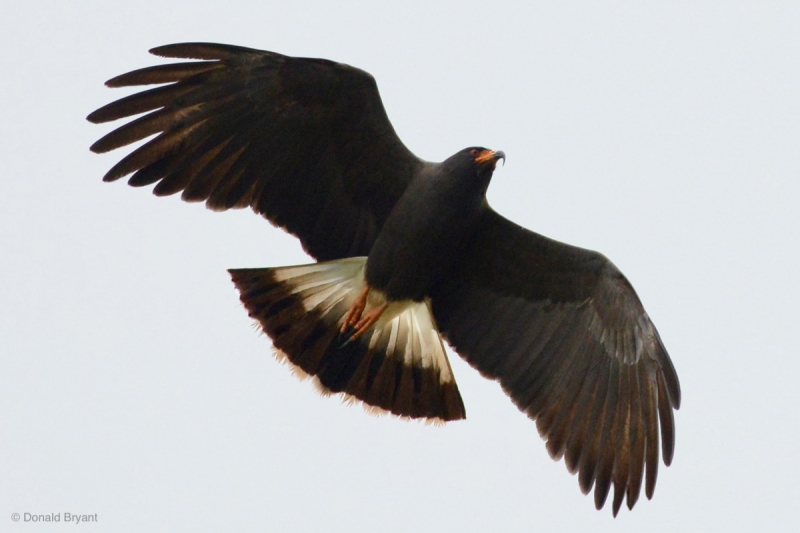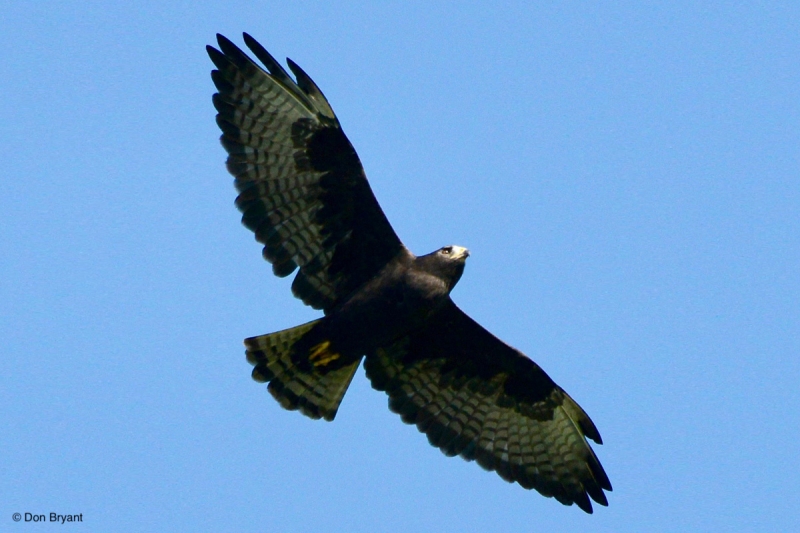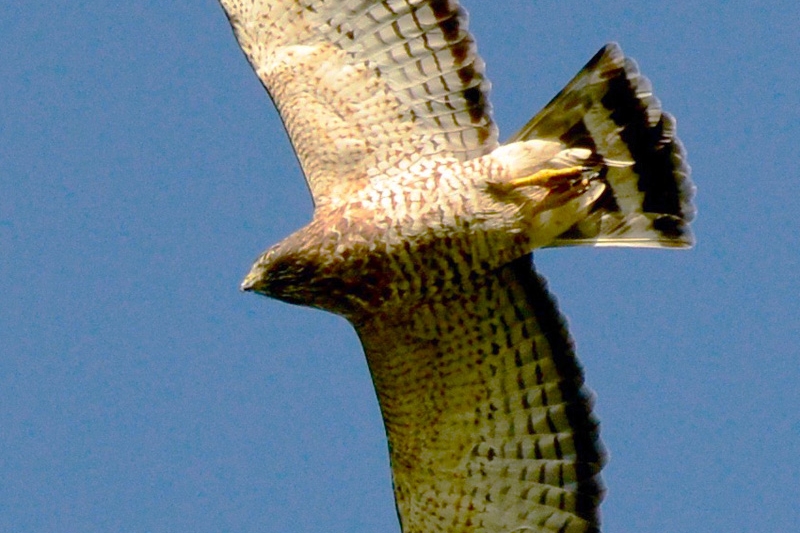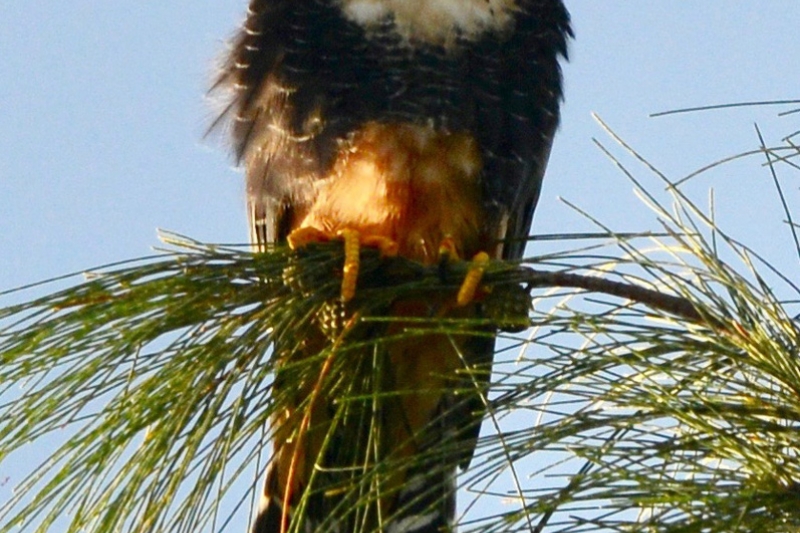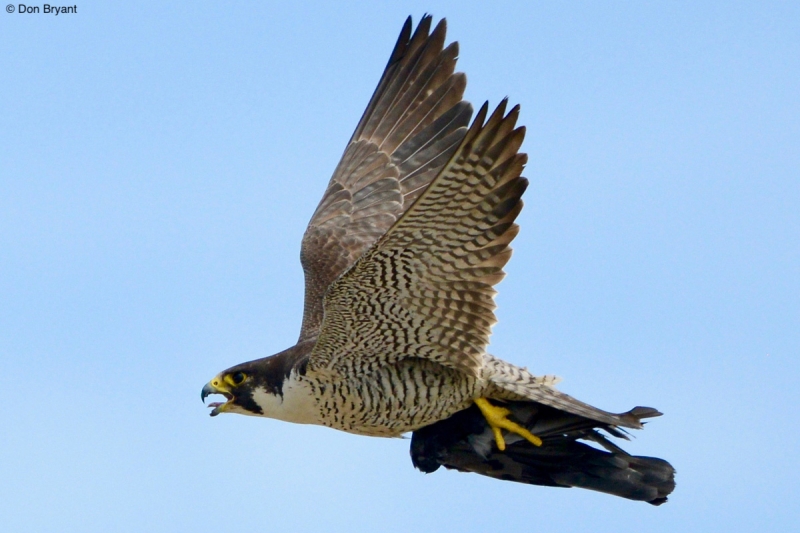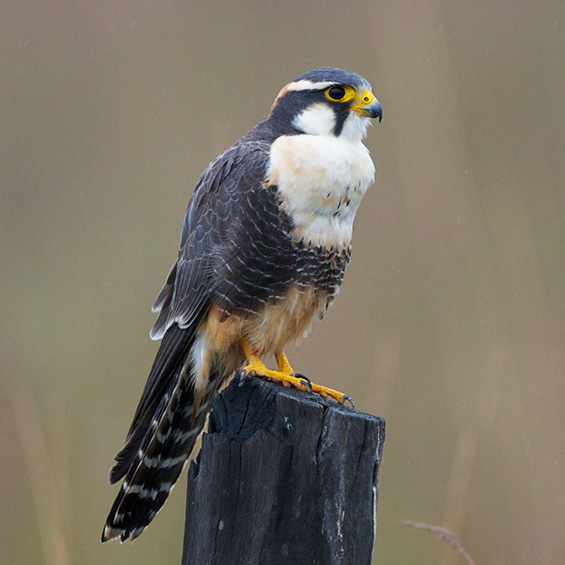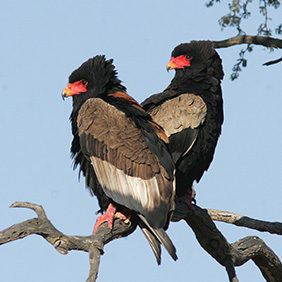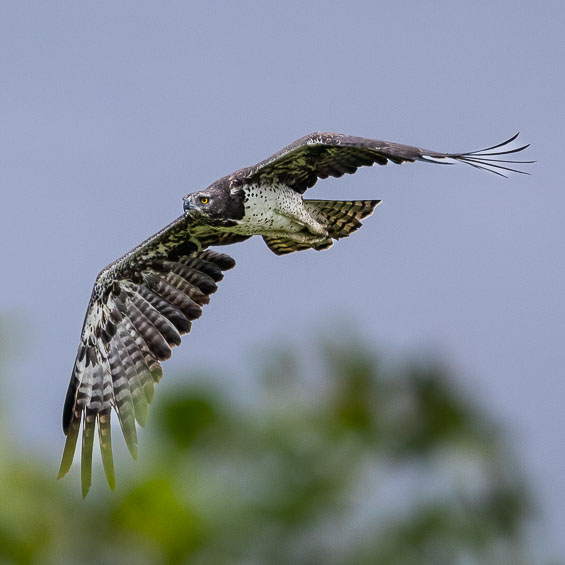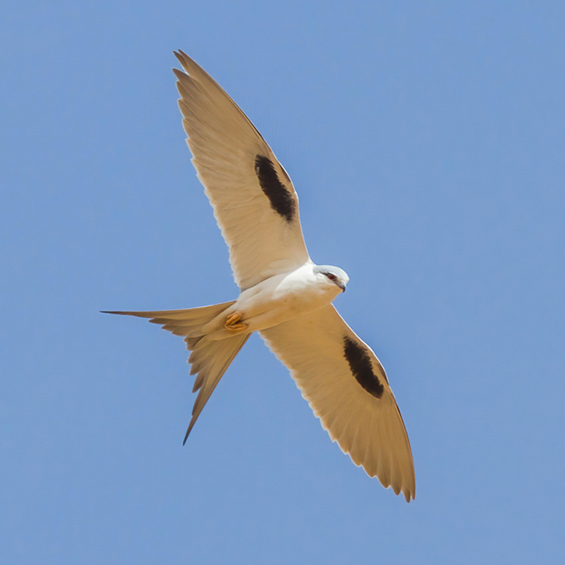2017 Veracruz River of Raptors Tour Report
Veracruz River of Raptors Tour Report 2017
Main Tour 4-12 October | Pre-Tour Extension 1-4 October
by Zach Smith
Eagle Pre-Tour Extension
Day 1 — Sunday, October 1
Today was for acclimation and a bit of sight-seeing in Veracruz for most of the Pre-Tour participants. By the evening, everyone had arrived and we were ready to be on the road early Monday for our first destination – the Sierra Juarez Mountains outside of Tuxtepec, Oaxaca. The main road crossing this mountain range, the Oaxaca-Tuxtepec Highway (175), winds along ridges and steep slopes overlooking tropical, cloud and pine-oak forests. Many locations along this road are typically reliable for views of the trio of mid-sized tropical hawk-eagles.
Day 2 – Monday, October 2
After a simple breakfast at our hotel, we were on the road. Antonio, our driver, made sure to take us on the autopista (toll road) which promised smoother driving than the free highway, which is full of topes (speed bumps). Our goals for the day were Ornate and Black Hawk-Eagles, plus Black-and-white Eagle and White Hawk. As we began the steep, winding ascent of Highway 175 (the Oaxaca-Tuxtepec Highway), the weather was clearing and conditions looked excellent for finding these birds. At km 59, we found two perched White Hawks. Even at a distance, these birds are a stunning white with subtle black trim on the primaries and tail. A good start. Around km 68, we spotted a Black-and-white Eagle perched close to the highway. Unfortunately, the bird did not stay still long enough for us to get a proper look. We pulled over at a good vantage point a short way up the road and found likely this bird perched in a distant tree below the road. The white head with black crown were unmistakable, but a closer look would have been nice. A couple more stops on the highway did not yield any more of our target species, but we did see a couple of migrant Broad-winged Hawks heading south through the mountains. On the drive back to Tuxtepec at dusk, we spotted our first Bat Falcon on a small radio tower on the outskirts of Valle Nacional. Shortly after we all had satisfying looks in the scopes, the bird took off, likely to hunt, and did not return. After a long first day in the field, cervezas and dinner hit the spot.
Raptor species observed: 10
Day 3 – Tuesday, October 3
Autumn is the rainy season in this part of Mexico, and we awoke to a very wet morning. We were hopeful the weather might clear at elevation and were determined to find hawk-eagles as we left a soggy Tuxtepec behind. At a gas station about ½ hour outside of Tuxtepec, we spotted an Aplomado Falcon perched in a field along the road. We jumped out and had some nice looks at this stunning falcon who did not look pleased with the wet conditions. Two Crested Caracaras were perched on a high-tension tower at the same spot. I chuckle at the relatively high proportion of good birds I’ve seen from Mexican gas stations – always worth a scan around while re-fueling. Up into the Sierra we traveled, but the weather was not cooperating... the rain and fog seemed to be getting heavier. ¡Ay, caramba! No raptor in its right mind would have been out in this weather. But we did encounter two Crested Guans along the road. At roughly 9,000 ft elevation, the highway reaches its highpoint at a roadside restaurant, La Cascada de Niebla (Misty Waterfall). Some hot cocoa and lunch cooked over a wood fire were welcome distractions from the challenging birding conditions outside. All weather reports indicated no improvement, so we headed back down the road to Tuxtepec. As we returned to the Valle Nacional area, the rain lightened so we pulled over in front of a small church to look for raptors. Antonio crossed himself, probably asking to be saved from the crazy birdwatchers. We found another Bat Falcon and were treated to a couple of hunting flights at close range. What an agile predator! We also got our first decent looks at Roadside Hawk here. One more stop on the road to Tuxtepec yielded a pair of Bat Falcons (male and female) and our first White-tailed Kite. Light was fading, so we had to call it a day. We spent the night at the hotel to rest up for the morning drive to Cardel.
Raptor species observed: 4
Day 4 –Wednesday, October 4
Rain greeted us again this morning, but the sky was clear to the east. Our route north to Cardel took us through pastureland and wetlands along Highway 145D. We took opportunities to stop along the highway and scan for raptors. The traffic was loud and made for less than idyllic birding, but the habitat was excellent for raptors, so we took advantage of a few wide pullouts. At our first stop in this area, we picked up Snail Kite and a distant Great Black Hawk. Roadside Hawks were being seen with regularity... along the road of all places! A short ways up the autopista we stopped again and hit the jackpot. In addition to our first decent kettle of Broad-winged Hawks (which included a Swainson’s Hawk), we got decent looks at two Great Black Hawks plus a very close Crane Hawk. This latter bird was an adult that spent several minutes in the sky. Amazing to get such looks at a species that is most often heard only! Also seen here were a few American Kestrels, Peregrine Falcons and Osprey. Here we got our firsttaste of the stunning waterbird migration that passes throughcentral Veracruz each autumn. There were nice looks at Wood Stork, American White Pelican and Anhinga. This was a timely transition to the Main Tour, which is focused on the migration and the huge kettles that were coming our way. After checking in at the famous (to hawkwatchers, at least) Hotel Bienvenido in the early afternoon, some of us spent time on the rooftop getting acquainted with the migration. Broad-winged and Swainson’s Hawks, Mississippi Kites, Osprey and Peregrine Falcons made appearances and whet our appetite for more raptor migration in the coming days.
Raptor species observed: 13
Main Tour
Day 1 – Thursday, October 5
After a couple of long days on the Pre-Tour Extension, we took it easy this morning with a mid-morning breakfast and a plan to focus on hawkwatching at Cardel and later at Chichicaxtle. The migration did not disappoint today. Kettles and streams of mostly Broad-winged Hawks kept the count team busy and all of us visitors gasping. A couple dark-morph individuals were spotted, these striking birds standing out in stark contrast to their light-morph companions. Several Swainson’s Hawks were seen, hinting at the growing numbers of this elegant western buteo. Impressive numbers of American Kestrels, Osprey and Peregrine Falcons were also on the move today. Peregrines often take up residence on Cardel’s cell towers, and one of them put on a great show by successfully nabbing a pigeon right in front of us. A few Mississippi Kites passed over, which was a delight since the majority of these graceful raptors pass by mid-September. We also had nice looks at a soaring dark-morph Short-tailed Hawk. This species is quite common in central Veracruz, but is still a striking buteo.
Afternoon found us on another roof, this time that of the Chichicaxtle observatory, several miles west of Cardel and the second official count site. On many days, the big streams of migrating hawks are pushed inland by the prevailing northeast winds in the afternoon. This was the case today and we hit it just right. Several large Broad-winged Hawk streams came over, getting quite close later in the afternoon. We also had a single Zone-tailed Hawk migrating along with one of the streams. By sundown, nearly 300,000 raptors had passed both count sites. Not the peak flight yet, but still incredibly impressive. Count totals today were 155,000 at Cardel, and 134,000 at Chichicaxtle.
Raptor species observed: 11
Day 2 – Friday, October 6
We spent the early morning birding at Playa Juan Angel, an area north of Cardel with dune, beach, scrub, wetland and some small groves of trees. Several windbreaks of Casuarinas (Australian Pines) have been planted here and they are favored perches of our primary target, Aplomado Falcon. We disembarked from our van to begin scanning for falcons. None showed up immediately, but we did have good general birding and a pair of calling Roadside Hawks. It did not take long for an Aplomado Falcon to appear, as a beautiful adult flew over and decided to perch in the closest Casuarina to us. Stunning! Two more of these elegant falcons were spotted on the distant treeline before we moved. The Rio Actopan empties into the gulf here, where a variety of water and shorebirds are seen. From the edge of the river, there is a decent view to the north of dunes that back the beach. Migrants were also starting to come over – several Osprey, Peregrine Falcons, American Kestrels plus a few Sharp-shinned and Cooper’s Hawks passed close by. One of the Peregrines was nicely picked out by Elizabeth perched on beach driftwood, which are favored hunting perches during migration. As the morning heated up, other raptors were starting to fly, and our first Hook-billed Kite made an appearance, albeit a distant one. A single Common Black Hawk soared up over the dunes, but did not venture terribly close. We noticed kettles forming on the way back to Cardel and were anxious to get onto the roof to take in the action.
The late morning flight at Cardel was not overly spectacular. We definitely saw some nice kettles and streams, but the flight slowed noticeably by early afternoon. A Hook-billed Kite was picked out as it tried to sneak by high overhead. As we did yesterday, we moved to Chichicaxtle for the afternoon. Not only is Chichicaxtle usually the place to be in the late afternoon, it is considerably quieter and more relaxing than Cardel. And today, "Chichi" was very good. Kettles and streams filled the sky between 4 and 6 pm. We picked out several Broad-winged Hawks as well as a few Zone-tailed Hawks. Swainson’s Hawk numbers were significantly higher than the previous day, and we saw all morphs and ages. A stunning adult Gray Hawk soared close to the tower as did at least two Short-tailed Hawks. As the sun descended in the sky, so to did the flight. Hawks were struggling for lift as they drifted south less than 100 feet overhead. There would be hawks roosting nearby tonight. When we left, birds were still coming over. Incredibly, the vast majority of the day’s 185,000 birds were counted in the last 3 hours.
Raptor species observed: 14
Day 3 – Saturday, October 7
In an unfortunate turn of events, I fell ill the night before and was unable to accompany the group for the day’s adventure. Fortunately, Elizabeth was more than capable of taking over for the day. The popular coastal site of La Mancha was the morning destination. This popular birding spot sits next to a mangrove-lined lagoon with good patches of tropical lowland forest nearby. The main target here is Collared Forest-Falcon. The group gave it a good effort, but was unlucky to not detect one of these secretive raptors. A single Ferruginous Pygmy-Owl was heard but not seen along the road – a reliable spot for this tecolotito (small owl). At the lagoon edge, the general birding is pretty good, notably for migrants passing low overhead. The group spotted several raptors here – Mississippi Kite, Osprey, Sharp-shinned Hawk, Zone-tailed Hawk, American Kestrel, Merlin, and Peregrine Falcon.
Back at the hotel, the migration was slow. Chichicaxtle was not much better. Yes, even in Veracruz there are slow days. However, this statement must be put in perspective – totals for the count sites today were 27,000 at Cardel and 14,000 at Chichi. Many sites in the US don’t tally this many birds in an entire season. Anyway, the group met up with gringo-turned-local bird guide Bob Straub and tried for a known pair of Bat Falcons near Chichi. They did see a falcon, but it was a Peregrine. Central Veracruz in fall – where Peregrines are the common falcon. Awesome!
Raptor species observed: 12
Day 4 – Sunday, October 8
As the sun came up, sickness was mostly behind me and I was ready to get back to hawkwatching. We headed to Rio Escondido for the morning, an interesting spot west of Chichicaxtle. Here, a dirt road travels through overgrown pasture/scrub and eventually runs along the north rim of the Rio Antiqua canyon. Migrant raptors often roost in great numbers along the canyon rim, so the morning lift-off flight can be spectacular. Additionally, the general birding and butterfly watching is excellent. As we worked our way along the canyon rim, we flushed a few raptors along the road – Roadside and Broad-winged Hawks. As the earth and air heated up, birds began rising from the north side of the canyon. We had great looks at Broad-winged Hawk, Gray Hawk, Short-tailed Hawk (dark), Osprey, Sharp-shinned Hawk and American Kestrel. The heat was beginning to slow us down a bit, so we headed to the town of Rinconada for a delicious lunch at a colorful roadside restaurant. Soon after, we headed Chichicaxtle. Raptor diversity was not too high this afternoon, but a single Hook-billed Kite caught our attention. The migration had picked up a bit since yesterday, with a total of just over 100,000 tallied between Chichi and Cardel. Hopefully the peak would happen while we were still in Veracruz.
Raptor species observed: 11
Day 5 – Monday, October 9
We spent all day today in the Alvarado area trying for our final target bird – Black-collared Hawk. This stunning, cinnamon-colored raptor enjoys the wet habitats in and around the mangrove-lined Alvarado Lagoon. Driving access to prime habitat is not easy, but we were optimistic. We turned off the main highway at the small town of Las Salinas. Here we stopped to ask directions from locals, and lucked onto a perched Ferruginous Pygmy-Owl, keenly spotted by April. Close looks and photo opps were enjoyed for several minutes. We continued along the northwestern edge of the lagoon through wet pastures. The habitat was not ideal for our main target, but it was just fine for Great Black-Hawk, and we found one perched close to the road in no time. Unfortunately, the bird was backlit by the rising sun, but the extensive black on the bill was diagnostic. We had nice looks at Northern Jacana, Crested Caracara and Loggerhead Shrike (honorary raptor?). We retraced our steps and headed to La Fregata, a delightful seafood restaurant with an expansive view of the Lagoon. Here we spotted a resting Roadside Hawk and enjoyed American Kestrels migrating south at close range and a couple Osprey over the lagoon. We continued east of Alvarado to highway 175 to where a Black-collared Hawk was seen recently. No hawk, but a couple Snail Kites foraged near the highway. The birds were a bit distant, but there was no mistaking these distinctive kites as they looked for snails. We still had one major stop to make on our way back to Cardel: Las Barrancas, a popular spot with excellent grassland habitat west of Alvarado. We encountered a couple Northern Harriers, Sharp-shinned Hawk, Crested Caracaras, American Kestrel, Aplomado Falcon, Peregrine Falcon, and arguably our best non-raptor sighting of the trip... Jabiru Storks! Here we bumped into a few of the VRR count team on a day off. They were all crammed into a tiny sedan and having a great time. Miss those days. Yes, even when work is birding, a day off in Veracruz is almost always best spent... birding. While our main target for the day eluded us, we were satisfied with another great day of birding in this amazing place.
Raptor species observed: 12
Day 6 – Tuesday, October 10
Not only did the morning bring more rain, but the appearance of Raptours’ Queso Grande, Sergio Seipke. Unfortunately, he had business items with which to deal, so did not join us for our morning outing - a return visit to La Mancha. The rain was intermittent as we birded the road into the lagoon. Not much was seen apart from a couple of Roadside Hawks. Detecting a Collared Forest-Falcon in these conditions was not likely, but we spent as much time as the weather allowed looking and listening for this unusual raptor. As we neared the lagoon, we came across a roosting Common Black-Hawk deep in the mangroves. By now the rain was really coming down and lightning was adding to the climatic excitement, so we drove to the lagoon to get a view and wait out the rain. The rain diminished to a drizzle for a bit and we enjoyed migrants passing overhead – an Osprey, Mississippi Kites, Northern Harrier, a few Sharp-shinned and Cooper’s Hawks, American Kestrels, a Merlin and a Peregrine. We did pick up a couple more Common Black-Hawks across the lagoon moving around the treetops as well as an adult Gray Hawk. A couple close lightning strikes put an end to our lagoon birding, so we drove back out to a small cafe along the entrance road. Drinks and snacks kept us busy until the rain eventually stopped. It was mid-morning now and since we were already here, we headed a short ways north to Quiahuitzlan. This historic burial site, nestled on the flanks of a spectacular volcanic monolith, affords expansive views of the gulf coast. Raptor migrants often roost in the surrounding forest and birds will rise and pass at eye-level or below. We saw some small groups of Mississippi Kites and Broad-winged Hawks, in addition to Sharp-shinned and Cooper’s Hawks, Gray Hawks, Zone-tailed Hawk, American Kestrels and Peregrine Falcons. A Ferruginous Pygmy-Owl called from the adjacent forest but remained unseen. Even if the raptor flight was on the slow side, this site is definitely a worthwhile destination.
Back in Cardel, the flight did not really materialize. The same could be said for Chichi, but we spent an enjoyable afternoon on the observation tower. This would be our last visit to this incredible installation – just a small building at the edge of a football field that is a portal to connecting countries and cultures. Even if the flight was slow, we managed to record 13 raptor species during our afternoon visit. That sums up how special this place really is.
Raptors species observed: 18
Day 7 – Wednesday, October 11
The weather forecast for today indicated thunderstorm activity was possible along the coast at Alvarado. This was not good news for a boat ride on the lagoon, so we cancelled that plan. We would have to find Black-collared Hawk from the roads around the lagoon. Our first stop on the east side of Alvarado produced great looks at a couple of adult Common Black-Hawks. We returned to our Snail Kite spot from a couple days ago and were rewarded with four actively hunting birds. It looked like a family group. A couple Lesser Yellow-headed Vultures glided along the nearby hillside, providing a nice opportunity to study this species at close-range. Next was the Highway 175 toll booth. Here we discovered an adult Great Black-Hawk low in the mangroves near the booth. The bird was feeding on something we could not see, but we had excellent looks through the fence. Rain was on and off as we continued south into nice habitat of flooded fields and pastures. A couple more Common Black-Hawks were seen along with Roadside Hawks, and Osprey. Flooded streets awaited us in the riverside town of Tlacotalpan, our lunch stop. We turned back toward Alvarado after eating and stopped periodically to look for Black-collared Hawk with no luck. ¡Qué lástima! Another stop at the toll booth produced spectacular looks at a flyover adult male Snail Kite and adult Gray Hawk perched beside one of the roadside ponds. This would be our last real stop, even though our eyes were peeled on the drive back to Alvarado for any and all raptors. The trip really ended after our evening farewell dinner at La Bamba, a Cardel restaurant recommended by our fearless driver Antonio. Everyone loved it, a fitting end to the tour.

